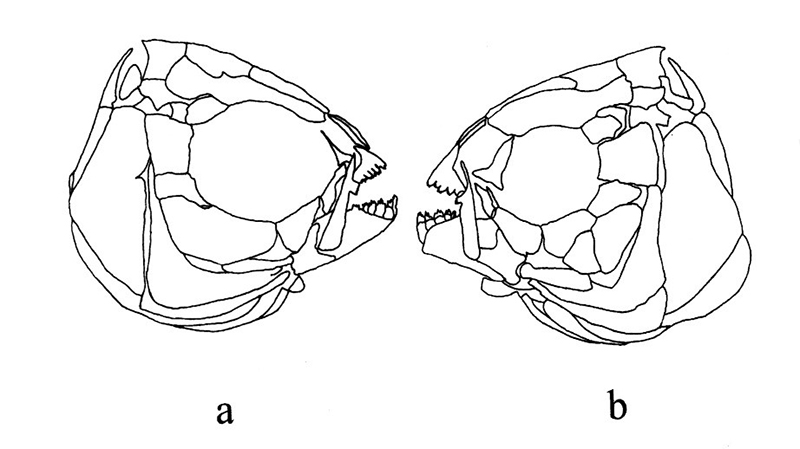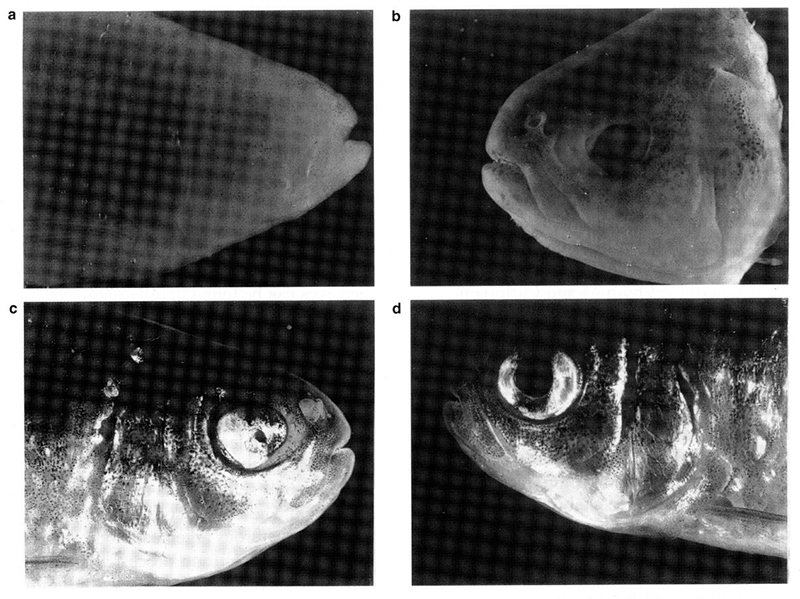Astyanax aeneus
(Günther 1860)

| ORDER | SUB-ORDER | FAMILY |
|---|---|---|
| Characiformes | Characoidei | Characidae |
Note
Espinasa, Rivas-Manzana and Espinosa Perez (2001) describe a stygobitic, hypogean population from Mexico and the following details relate only to the hypogean animals.
Synonyms
None.
Country
MéxicoTypes
This species has not yet been described as new so there are no types. The best current description is in Espinasa, Rivas-Manzana and Espinosa Perez (2001).
Distribution
“Type locality” of the hypogean animals: Gruta de las Granadas, north-east of Taxco, Guerrero, southern México (18o34’30”N, 99o33’7”W). The stream flowing from the cave is a tributary of the Amacuzac River. Known also from Resumidero La Joya in the same area (Espinasa 2018).
Habitat
The collection site is a cave passage 180m long to a sump pool. The cave is a resurgence and water flows out of it all year round. Within the cave there is a mixed population of the stygomorphic, presumably stygobitic, animals and ordinary surface animals. Only about 10% of the population are stygomorphic. This suggests that their true habitat is undiscovered and lies further into the cave.
Systematics
From the few data available it appears that the stygomorphic animal is a separate taxon from the epigean animals and that it is currently hybridising at the collection site. This situation is analogous to that of Astyanax jordani in La Cueva Chica (Breder 1942) and perhaps Poecilia mexicana and Rhamdia urichi at their only known sites. Should this turn out to be the case a new name would be appropriate to differentiate the taxon.
Conservation Status
TMP [NE]
The hypogean population of this species is currently known from only two sites and is therefore VU D2 at least.
Museum Holdings
None known.
Key References
- Zeitlin, S. M. and McDevitt, D. S. (1973)
- Espinasa, L. (1986)
- Espinasa, L., Rivas-Manzano, P. and Perez, H.E. (2001)
- Mirande, J.M. (2010)
- Espinasa, L. (2011)
- Esquivel-Bobadilla, S (2011)
- Pazza, R., Bertollo, L.A.C., de Almeida-Toledo, L.F. and Kavalco, K.F. (2013)
- Palacios-Vargas, J.G., Juberthie, C. and Reddell, J. (2014-2015)
- Silva, D. M. Z. A., Utsunomia, R., Pansonato-Alves, J.C., Oliveira, C. and Foresti, F. (2015)
- Schmitter-Soto, J.J. (2016)
- Schmitter-Soto, J.J. (2017)
- Devitsina, G.V. and Golovkina, T.V. (2018)
- Elliott, W.R. (2018)
- Pazza, R., Dergam, J.A. and Kavalco, K.F. (2018)
- Espinasa, L. (2018)
- Mirande, J.M. (2018)
- Borowsky, R., Luk, A., He, X.J. and Kim, R.S. (2018)
- Pastana, M.N.L., Bockmann, F.A. and Datovo, A. (2019)
- Terán, G.E., Benitez, M.F. and Mirande, J.M. (2020)
- Mercado-Silva, N., Ornelas-Garcia, C.P., Schmitter-Soto, J.J., Gidmark, N.J. and Simons, A.M. (2020)
- Warren, M.L. and Burr, B.M. (2020)
- Schmitter-Soto, J.J. (2021)
| Zeitlin, S. M. and McDevitt, D. S. | Journal Article | 1973 | Flourescent antibody study of the developing lens of the blind cave fish |
| Espinasa, L. | Journal Article | 1986 | Exploraciones biospeleologicas en Guerrero |
| Espinasa, L., Rivas-Manzano, P. and Perez, H.E. | Journal Article | 2001 | A new blind cave fish population of genus Astyanax: Geography, morphology and behaviour |
| Mirande, J.M. | Journal Article | 2010 | Phylogeny of the family Characidae (Teleostei: Characiformes): from characters to taxonomy |
| Espinasa, L. | Conference Paper | 2011 | Promoting undergraduate research in large classrooms: Guerrero cave Astyanax - Old or young colonisation? |
| Esquivel-Bobadilla, S | Thesis | 2011 | Análisis genético de Astyanax mexicanus (Characidae, Teleostei, Pisces) de la vertiente atlántica de México usando microsatélites. |
| Pazza, R., Bertollo, L.A.C., de Almeida-Toledo, L.F. and Kavalco, K.F. | Conference Paper | 2013 | Molecular systematics of the genus Astyanax - Starter edition |
| Palacios-Vargas, J.G., Juberthie, C. and Reddell, J. | Book | 2014-2015 | Encyclopaedia Biospeologica Mexico |
| Silva, D. M. Z. A., Utsunomia, R., Pansonato-Alves, J.C., Oliveira, C. and Foresti, F. | Journal Article | 2015 | Chromosomal mapping of repetitive DNA sequences in five species of Astyanax (Characiformes, Characidae) reveals independent location of U1 and U2 snRNA sites and association of U1 snRNA and 5S rDNA |
| Schmitter-Soto, J.J. | Journal Article | 2016 | A phylogeny of Astyanax (Characiformes: Characidae) in Central and North America |
| Schmitter-Soto, J.J. | Journal Article | 2017 | A revision of Astyanax (Characiformes: Characidae) in Central and North America, with the description of nine new species |
| Devitsina, G.V. and Golovkina, T.V. | Journal Article | 2018 | Structural Organization of the Taste Apparatus in Characins (Characidae, Teleostei |
| Elliott, W.R. | Book | 2018 | The Astyanax Caves of Mexico: Cavefishes of San Luís Potosí, Tamaulipas, and Guerrero |
| Pazza, R., Dergam, J.A. and Kavalco, K.F. | Journal Article | 2018 | Trends in karyotype evolution in Astyanax (Teleostei, Characiformes, Characidae): Insights from molecular data. |
| Espinasa, L. | Book Section | 2018 | The Guerrero fish population: Astyanax aeneus as a comparative cavefish model |
| Mirande, J.M. | Journal Article | 2018 | Morphology, molecules and the phylogeny of Characidae (Teleostei, Characiformes) |
| Borowsky, R., Luk, A., He, X.J. and Kim, R.S. | Journal Article | 2018 | Unique sperm haplotypes are associated with phenotypically different sperm subpopulations in Astyanax fish |
| Pastana, M.N.L., Bockmann, F.A. and Datovo, A. | Journal Article | 2019 | The cephalic lateral-line system of Characiformes (Teleostei: Ostariophysi): anatomy and phylogenetic implications |
| Terán, G.E., Benitez, M.F. and Mirande, J.M. | Journal Article | 2020 | Opening the Trojan horse: phylogeny of Astyanax, two new genera and resurrection of Psalidodon (Teleostei: Characidae) |
| Mercado-Silva, N., Ornelas-Garcia, C.P., Schmitter-Soto, J.J., Gidmark, N.J. and Simons, A.M. | Book Section | 2020 | Characidae: Characins |
| Warren, M.L. and Burr, B.M. | Book | 2020 | Freshwater fishes of North America. Volume 2 Characidae to Poeciliidae |
| Schmitter-Soto, J.J. | Journal Article | 2021 | New lectotype designation for Astyanax aeneus (Teleostei, Characidae) |
